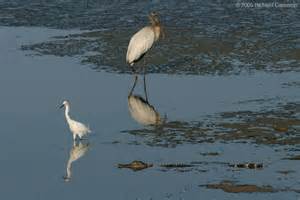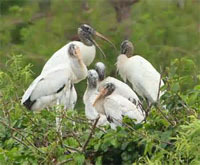
Wood stork photo courtesy of Becky Skiba
MONTGOMERY-While driving home last fall, I saw a flock of large black and white birds flying over the interstate. At first glance I thought I was looking at egrets, a common wading bird found throughout the state, but soon I realized these were federally endangered wood storks. This was a rare but exciting chance to see these birds that only briefly occur in certain areas of Alabama each year.
Wood storks are the only stork found in Alabama, and at around 4 feet  tall, the second largest wading bird. It has a wingspan of around 5 feet. These large, white birds have black tails and black wing tips. They also have distinct black, featherless heads and necks with long black bills that have a slight downward curve. They have been called such things as “ironhead” or “flinthead” because of their appearance.
tall, the second largest wading bird. It has a wingspan of around 5 feet. These large, white birds have black tails and black wing tips. They also have distinct black, featherless heads and necks with long black bills that have a slight downward curve. They have been called such things as “ironhead” or “flinthead” because of their appearance.
Wood storks were listed as federally endangered in the United States in 1984 after their populations plummeted from 20,000 pairs in the 1930s to only about 2,500 pairs in 1978. While populations have increased greatly to around 15,000 breeding pairs, they will continue to be listed as endangered until they have maintained a consistent population.
 Wood storks begin breeding in colonies or rookeries as early as December from Florida to South Carolina. While they are not known to breed in Alabama, wood stork breeding populations have been shifting north from Florida because of development. Therefore, storks may breed in remote wetlands of south Alabama now or in the future. Please report sightings of breeding wood storks in the state to any Alabama Wildlife and Freshwater Division office.
Wood storks begin breeding in colonies or rookeries as early as December from Florida to South Carolina. While they are not known to breed in Alabama, wood stork breeding populations have been shifting north from Florida because of development. Therefore, storks may breed in remote wetlands of south Alabama now or in the future. Please report sightings of breeding wood storks in the state to any Alabama Wildlife and Freshwater Division office.
In the summer when young birds are ready to fledge and feed  themselves, food sources in nearby feeding ponds are usually depleted, which causes the birds to disperse across the Southeast in search of fish and other foods such as frogs and crayfish. Wood storks will show up in Alabama in June and stay until around October foraging in shallow waters of south Alabama. Storks can be found in larger numbers in Montgomery, the Eufaula National Wildlife Refuge, along the Tombigbee River, and in catfish ponds and lakes in Hale, Marengo and Perry counties.
themselves, food sources in nearby feeding ponds are usually depleted, which causes the birds to disperse across the Southeast in search of fish and other foods such as frogs and crayfish. Wood storks will show up in Alabama in June and stay until around October foraging in shallow waters of south Alabama. Storks can be found in larger numbers in Montgomery, the Eufaula National Wildlife Refuge, along the Tombigbee River, and in catfish ponds and lakes in Hale, Marengo and Perry counties.
While there are larger populations of birds seen in certain areas of Alabama, wood storks can be seen all along the coastal plain region of the state foraging during the summer months. So next time you see a large white bird wading in shallow water, take a closer look. You may be watching one of Alabama’s federally endangered bird species.
MEDIA RELEASE/ALABAMA DEPARTMENT OF CONSERVATION AND NATURAL RESOURCES/BY: Carrie B. Johnson, Wildlife Biologist, Alabama Division of Wildlife and Freshwater Fisheries


